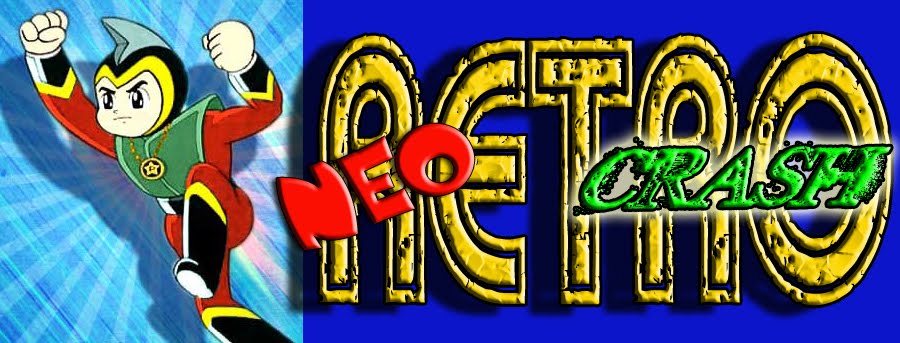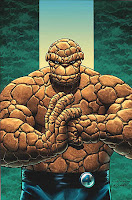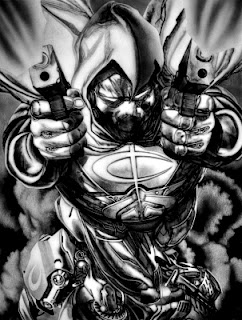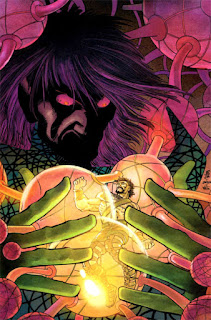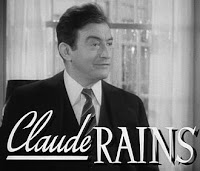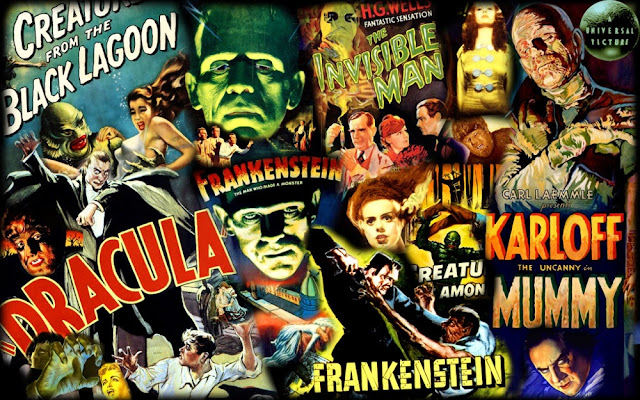I realize, that I've missed a few days, and I apologize, but somedays the muse bites and leads me on a path not appropriate for this blog and I must go elsewhere to flex my angst.
Today we must talk about the great lost achievement of Marvel comics. Much more often than DC, Marvel has tried to create heroes out of things that should be monsters. They may be the only comics to ever try to explore the particular emotional mindset of what it means to be trapped in a monstrous form..
Ben Grimm:- the Thing
Trapped in his monstrous form, Grimm is an unhappy yet reliable member of the team. He trusts in his friend Reed Richards to one day develop a cure for his condition. However, when he encounters blind sculptress Alicia Masters, Grimm develops an unconscious resistance to being transformed back to his human form. Subconsciously fearing that Masters prefers him to remain in the monstrous form of the Thing, Grimm's body rejects various attempts by Richards to restore his human form, lest he lose Masters' love. Grimm has remained a stalwart member of the Fantastic Four for years. The Thing first fought the Hulk early in his career, with many such further clashes over the years. Not long after that, he is first reverted to his human form, but is then restored to his Thing form to battle Doctor Doom.
The Hulk
The Hulk first appeared in The Incredible Hulk #1 (cover dated May 1962), written by writer-editor Stan Lee, penciled and co-plotted by Jack Kirby, and inked by Paul Reinman. Lee cites influence from Frankenstein and Dr. Jekyll and Mr. Hyde in the Hulk's creation:
It was patently apparent that [the monstrous character the] Thing was the most popular character in [Marvel's recently created superhero team the] Fantastic Four.... For a long time I'd been aware of the fact that people were more likely to favor someone who was less than perfect.... It's a safe bet that you remember Quasimodo, but how easily can you name any of the heroic, handsomer, more glamorous characters in The Hunchback of Notre Dame? And then there's Frankenstein... I've always had a soft spot in my heart for the Frankenstein monster. No one could ever convince me that he was the bad guy.... He never wanted to hurt anyone; he merely groped his torturous way through a second life trying to defend himself, trying to come to terms with those who sought to destroy him. ... I decided I might as well borrow from Dr. Jekyll and Mr. Hyde as well — our protagonist would constantly change from his normal identity to his superhuman alter ego and back again.
Kirby, commenting upon his influences in drawing the character, recalled as inspiration the tale of a mother who rescues her child who is trapped beneath a car. Lee has also compared Hulk to the Golem of Jewish mythology
The Ghost Rider
After a deal with the devil like character Mephisto to cure his Mentors Cancer, Johnny Blaze defeated the demon with the power of true love. Johnny later learned that demons are spiteful
Blaze was unaware that Mephisto had bonded him with the demon Zarathos as an act of revenge for not being able to obtain Johnny's soul for himself. Johnny was transformed into a Ghost Rider, a leather-clad skeleton, his head cloaked in a sheath of flame, the night after Crash's death. While Johnny still had his soul, he was forced to punish the wicked and evil upon Mephisto's demands whenever needed. Whenever he was in the presence of evil he would transform into the Ghost Rider, to exact the devil's revenge, returning the evil to Hell. Blaze was not completely lost in the transformation however, and would also help the innocent when they were in danger
Sasquatch
Dr. Walter Langkowski is a member of Alpha Flight, a native of Vancouver, British Columbia, Canada of Polish Jewish origin and a renowned physicist, and a professor of both physics and biophysics at McGill University. He is also a former football player for the Green Bay Packers.
He possesses the ability to transform into a super-strong, orange-haired beast resembling the legendary Sasquatch. This transformation is triggered by willpower. In his transformed state, Langkowski has increased strength, stamina, and resistance to injury. He also has sharp claws and is able to leap incredible distances.
These powers were a result of Langkowski's self-experimentation with gamma radiation. In an attempt to become like the
Hulk, Langkowski bombarded himself with a gamma ray projector at his laboratory near the Arctic Circle. As a proposed explanation for why he transformed into an orange instead of green behemoth (as gamma-irradiated persons are usually affected), Langkowski assumed it had something to do with the Aurora Borealis.
However, unknown to Langkowski, it was not the gamma rays that turned him into Sasquatch, but the fact that his lab equipment opened a doorway between our world and the "Realm of Great Beasts." When this portal was opened, a mystical beast called Tanaraq invaded Langkowski's body and granted him his powers. Langkowski had to learn to maintain his own personality and intelligence when in the form of Sasquatch, and was very successful for a time.
Marvel even took a stab at more traditional monsters. The conversion was not always well executed or thought ou, but you had to appreciate the attempt. Marvel may be the first folks to try and create the good guy vampire. I can't prove that it led to Twilight, but curse them if it did.
Morbius, the Living Vampire
Michael Morbius experienced a transformation by electrical shock treatment and chemical ingestion into a pseudo-vampire. As a pseudo-vampire, Morbius does not possess all the powers of an actual vampire, nor is he subject to all the traditional limitations and weaknesses thereof. He possesses a variety of superhuman powers, some of which are similar to supernatural vampires within the Marvel Universe. Due to his vampire-like condition, Morbius is forced to ingest fresh blood on a regular basis to sustain his life and vitality. How much blood he requires and how often he has to feed has not been specified in the comics. However, Morbius does not possess any of the mystical vulnerabilities that supernatural vampires are subject to, such as garlic, holy water, crucifix, or silver. Morbi
us has a strong aversion to sunlight, thanks to his photo-sensitive skin which prevents any protection from major sun burn, in contrast to "true" vampires that are incinerated by it, with the result that he can move in daylight but his powers are diminished and he will stick to the shade if circumstances demand him to be active during the day. Morbius also lacks the shape-shifting and weather-control powers, and the ability to control animals, of vampires. Like "true" vampires, Morbius does possess the ability to hypnotize beings of lesser willpower and bring them under his control, which can only be resisted by those possessing an extremely strong will. While briefly infected by the demon Bloodthirst, Morbius gained the ability to liquidize his body, moving through small spaces and stretching his limbs as needed.
Jack Russell, Werewolf by Night
The History Of Jack Russell is long and complicated and reads like the script of a bad Werewolf Movie. Needless to say Jack Russel spent years on the road helping people out and ,during the three night of the full moon, turning into a savage Werewolf,
While reports of lycanthropy (becoming a werewolf) in the Russoff line stretch back many centuries, the first confirmed manifestation is Grigori Russoff in 1795. Dracula slew Grigori's wife Louisa after he refused to acknowledge Dracula's primacy upon his return to Transylvania. Grigori then ambushed and destroyed Dracula, but was turned into a werewolf by Lydia, a werewolf formerly imprisoned by the vampire lord. Grigori took a second wife, but accounts vary as to why lycanthropy failed to pass to his descendents. Sometime prior to May 1930, Grigori's descendent, Gregor, obtained the legendary Darkhold scrolls, binding them back into book form. Reading lycanthropy's origins in the Darkhold under a full moon triggered the dormant curse, turning Gregor into a werewolf. Gregor further transcribed much of the Darkhold into Grigori's diary, essentially creating a Darkhold copy, which he used as his own diary.
Gregor sold part of his estate — including Wundagore Mountain — to Jonathon Drew, who shared it with partner Herbert Wyndham (the future High Evolutionary). The Russoff werewolf slew Jonathon's wife, Merriem, and Wyndham designed a suit of silver-coated armor to protect himself, enabling Russoff's capture. Russoff stayed with the Evolutionary, who kept the werewolf safely contained for decades. Russoff eventually used the Darkhold to summon Chthon to cure him, and the Elder God nearly broke through the earthly plane; but Magnus the Sorcerer forced Russoff to banish Chthon, who lashed out with a parting blast that slew Gregor. Despite contrary accounts, the Gregor Russoff who stayed with the High Evolutionary seems to have been the grandfather (or great-grandfather) of Jack Russell. Having the same name and presumably using the same diary contributed to earlier confusion. It would seem more likely that the elder Gregor was the one who transcribed the Darkhold into the diary.
Decades later, another Gregor Russoff married Laura, the former girlfriend of his younger brother Philip. Jacob (later Jack) was born in Mediaş, Transylvania, soon after, and Laura was pregnant with Lissa within two years of marriage; however, when lightning struck Russoff's Transylvanian castle during a full moon, the werewolf Gregor escaped confinement and began attacking villagers. They tracked down and killed Russoff with silver bullets. Gregor's mother, Maria, was stoned and driven from the village, living with gypsies and learning magic. After Gregor's death, Laura found Philip - who had moved to Los Angeles, anglicizing his name to Russell - and they married after a year; Jack and Lissa remained unaware of Philip's past.
Approximately fifteen years later, the criminal Committee learned of Gregor's curse and blackmailed Philip, threatening to reveal his secrets. To protect Laura's name, Philip paid them but had second thoughts and canceled payment, causing the Committee to send Max Grant to kill Laura. Critically injured in a car crash on Jack's 18th birthday, Laura barely had time to tell Jack about his true father and the curse of the werewolf, making Jack promise not to harm Philip, before dying. Having inherited lycanthropy the night before, Jack slew Grant, but wrongly blamed Philip for some time. Laura left Castle Russoff in Jack's name, but Philip, the trustee, sold the castle to Miles Blackgar, who had it moved to an island off California's coast. Jack battled a motorcycle gang, infecting its members with lycanthropy.
Jack spent the next few years as a traveler, transforming on the three nights of the full moon into savage werewolf form. He learned of the Darkhold from Nathan and Agatha Timly, who briefly kidnapped the Werewolf and met grisly ends. Befriending writer Buck Cowan, Jack sneaked into Blackgar's castle and stole the Darkhold, encountering Miles Blackgar and his daughter Marlene, whose petrifying power slew both Blackgars. After fighting off the deformed Cephalos' plot to drain his power to stabilize Cephalos' form, Jack had Father Ramon Joaquez translate the Darkhold. The priest died after being possessed by the Darkhold's former custodian, 12th century Mad Monk Aelfric, and the indestructible Darkhold vanished. Jack encountered Joshua Kane, who hunted the Werewolf, and his brother, Luther Kane, who offered to prevent Lissa from becoming a werewolf in exchange for Jack kidnapping billionaire recluse Judson Hemp; he met mentalist Swami Rihva, who sought the Werewolf's blood to reveal the treasure-map of the ancient sorcerer Kaman-Ru on his "Bloodstone"; the possessing demon Krogg; and Spider-Man and Moondark the Magician. Jack then fought the sonic-weapons of Sarnak, his first brush with the criminal Committee who wished to enslave the Werewolf.
Frankenstein's Monster
Frankenstein's Monster was built from human corpses by a scientist named Victor Frankenstein, in Ingolstadt, Bavaria, in the late 18th century. His efforts to fit in with regular humanity were futile due to his horrific form, and he was infuriated. Victor Frankenstein created and subsequently killed a mate for the Monster, who killed Frankenstein's bride Elizabeth in retaliation. After killing several people, the Monster fled to the Arctic. His creator pursued him, but died due to the cold. The Monster, anguished, tried to kill himself but only went into a state of suspended animation from the cold.
In the 1890s, heat revived the Monster and he wandered again. He searched for the descendant of Victor Frankenstein and finally ended up in Transylvania. The Monster clashed with Dracula, and his vocal cords were injured. Vincent Frankenstein finally found him and tried to give him a new brain, dying in the process as he was shot by an angry maidservant before the Monster could kill him. Frustrated, the Monster returned to a state of suspended animation.
At some point, the Monster was temporarily pulled out of time to serve in Kang the Conqueror's Legion of the Unliving to fight the Avengers.
The Monster eventually emerged from suspended animation in a glacier to the modern world. He was aided by Victoria Frankenstein, a distant relative of his creator. This woman was kindly, and repaired his vocal cords. The Monster joined Victoria Von Frankenstein and her mutant charges, the Children of the Damned, beings who were mutated by Basil and Ludwig Von Frankenstein's failed human experiments. The Monster allied with Spider-Man against the Monster Maker, Baron Von Shtupf and his pawn the Man-Wolf
